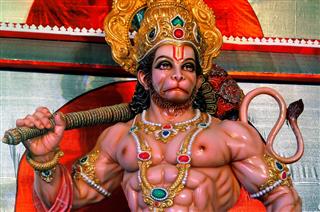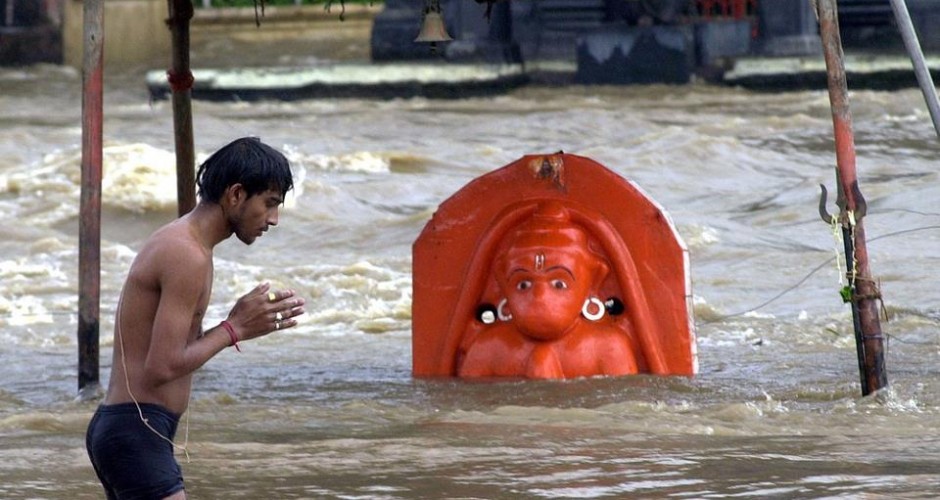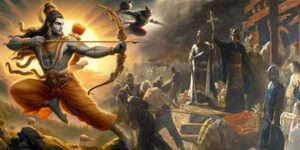”Why do you worship an idol?” is a question frequently encountered by some Hindu’s. Another common question is, “Why do you worship a rock?” This is an excellent opportunity for a Hindu, or follower of Sanatana Dharma, to educate their momentary student of spirituality or religion.
Followers of Sanatana Dharma (Hinduism) do not worship idols, rocks or metal; rather, they worship a murti. To the average person outside of Hinduism, there is little difference between the rock, metal image or murti. But the difference is significant, and forms the heart of modern, as well as ancient Hinduism.
While most people can agree that divinity is everywhere, or at least some variation of this belief appears in most of the world’s major religions. Worshiping a rock or idol is literally that, worshiping a rock or idol. This is not the same as performing acts of devotion with a murti. A great deal of confusion continues to exist between the words idol and murti. It is common to see the word idol used within Hinduism, and this confusion in terms is rampant on the Internet. Some people confuse a rock or idol for a murti; in reality, they cannot be compared.
 Murti means form, personification, and most importantly embodiment. The embodiment, form and personification is NOT the form carved into the stone, or cast in metal; rather, the stone or metal cast must become ‘energized’ or made into a receptacle of the Divine energy that it will contain. An idol is just what its name implies; it is an idol and nothing else. At best, an idol is a stage in the process of becoming a murti.
Murti means form, personification, and most importantly embodiment. The embodiment, form and personification is NOT the form carved into the stone, or cast in metal; rather, the stone or metal cast must become ‘energized’ or made into a receptacle of the Divine energy that it will contain. An idol is just what its name implies; it is an idol and nothing else. At best, an idol is a stage in the process of becoming a murti.
A murti is the final step in the process that begins as a rock (or metal), which is carved or cast into an idol. The idol is purified by a variety of pujas and mantras. Once this process has been completed, the idol is ready for the final stage, which is to have the Divine energy installed making the idol a murti.
This energy is maintained by various mantras, pujas, and offerings. Upon the completion of this process, the murti has become a physical manifestation or embodiment of the Divine energy, or deity. The murti serves as a place for Divine communion, and serves as a focused and concentrated receptacle in each home or temple.
Is the murti the totality of Divinity? This is a difficult question. To explore this important question, the Shiva Lingam and Yoni provides some useful insight. As only about 1/3 of the lingam is inserted into the yoni, illustrating that about 1/3 of Divinity comprises all of creation. So to say that a murti contains the sum total of Divinity would not be entirely correct, according to this teaching but it is a communication portal to this divine totality.
There is an important teaching involving Ganesh that provides additional insight into this question. To paraphrase, there was a great race to take place between Ganesha and his brother. All the Gods were present to witness this race, as it would be throughout the universe. The goal was to race throughout the entire universe and return.
The first to complete this race would be the victor. Both participants prepared to begin the race; the starter sounded the beginning of the race. The brother of Ganesh was quickly off; while Ganesh did not move. The Gods asked Ganesh, “Why are you standing there?” Ganesh replied, “The race is throughout the universe, correct?” The Gods replied, “Yes.” Ganesh explained that since he is one with the universe, he is everywhere at all times, and therefore has won the race without ever leaving the start line.
 Therefore, the murti is not the total of Divinity, but is a part of the totality of Divinity. Additionally, another way of viewing this in modern computer terms would be that the murti would be an ‘interface’ for the spiritual seeker. It serves as a portal for communication to the Deity, as it is Divine energy, but is not the sum total of the Deity.
Therefore, the murti is not the total of Divinity, but is a part of the totality of Divinity. Additionally, another way of viewing this in modern computer terms would be that the murti would be an ‘interface’ for the spiritual seeker. It serves as a portal for communication to the Deity, as it is Divine energy, but is not the sum total of the Deity.
Much like our body is a vessel, receptacle or form of expression of our soul. As we spiritually evolve, we ourselves awaken to the realization that we are an embodiment of elements of the Divine energy or various forms of Divinity. For an idol or metal cast image to become a murti, it is prepared using specific techniques, just as yoga is used to prepare our mind and body for realization of our Divine essence, for example.
Divinity, in relation to a murti, is not just someone relating to it as Divine in and of itself, but is a systematic cleansing, preparation, and installation of Divine energy into a concentrated location that truly makes a murti–a murti!
There are numerous appropriate receptacles of this Divine energization; the most common being stone and metal. But it is common for mountains to be viewed this way, as well as other sacred locations, temples, and rivers. Natural minerals, such as stone and crystal, are commonly used for murti. Other materials may be used, but stone and metal are the most common. Interestingly, the harvesting and preparation of the stone determines the stones ability to hold more Divine energy.
In harvesting stone, modern mining techniques, such as using dynamite, cause microscopic cracks in stone. These cracks reduce the stones ability to hold Divine energy. But, the cracks do not impede the stone’s ability to hold Divine energy or consciousness. A modern example of this is underway in Kauai, Hawaii. The Iraivian Temple, under construction at Kauai’s Hindu monastery, is using ancient techniques to harvest stone, and prepare the stone using ancient techniques that preserve the stones inner quality to retain Divine consciousness or energy.
 We have been examining the murti in the outer form of worship. There is a place for the murti in the inner form of worship, as well. The murti may also exist within our hearts. This is most commonly observed in Advaita Vedanta and other non-dualistic systems. The internal murti can also be a part of Bhakti yoga.
We have been examining the murti in the outer form of worship. There is a place for the murti in the inner form of worship, as well. The murti may also exist within our hearts. This is most commonly observed in Advaita Vedanta and other non-dualistic systems. The internal murti can also be a part of Bhakti yoga.
It is also possible and common for the internal and external murti’s to be a part of the Bhaktas life, as with any practitioner of spirituality, Hinduism or yoga. In fact, for some practitioners of yoga sadhana itself may be a journey from the outer murti to the inner murti. One may visit the temple and commune with the Deity, and likewise chant a mantra to the deity while holding the murti image within their heart.
 In tantra, the murti can be represented by a yantra, this is a bold step into the world of mathematics and abstractness. As the yantra represents the body of the deity, the mantra represents the mind of the deity. This is externally practiced by looking at a yantra and performing japa (repetition) of a mantra.
In tantra, the murti can be represented by a yantra, this is a bold step into the world of mathematics and abstractness. As the yantra represents the body of the deity, the mantra represents the mind of the deity. This is externally practiced by looking at a yantra and performing japa (repetition) of a mantra.
A more subtle way to practice is to visualize the yantra and perform japa. This requires a higher degree of concentration, but can lead to a deeper level of meditation; though both forms are legitimate and important.
As the greatest importance has been placed on the murti; the idol has a place in the world. The idol serves as an image to remind the mind of various principles, qualities, and Divine manifestations. Subconsciously, these are reinforced each time one sees an idol. Likewise, they are more strongly reinforced by the murti. So images, idols etc. have their place in the realm of cosmic affirmation and reminding the mind of various Divine teachings.
 So the Hindu does not worship an idol, stone, or even metal, but rather Hinduism has preserved an ancient understanding of the relationship between humanity and divinity. These ancient techniques comprise the greatest achievements of humanity, encompassing the greatest minds of their time.
So the Hindu does not worship an idol, stone, or even metal, but rather Hinduism has preserved an ancient understanding of the relationship between humanity and divinity. These ancient techniques comprise the greatest achievements of humanity, encompassing the greatest minds of their time.
Minds that were focused on Divinity; divinity was the technology of their day, as opposed to the technology of our modern day. Hinduism has preserved the crowning achievement of humanity’s spirituality, not that this knowledge was not possibly known in other parts of the world, but rather Hinduism has become the largest repository and caretaker of this ancient knowledge. The murti takes humanity on the greatest journey; where the unknown becomes known. Hope, grace, spirit and matter all merge.
By Yogi Baba Prem Yogacharya, Vedavisharada
































1 Comment